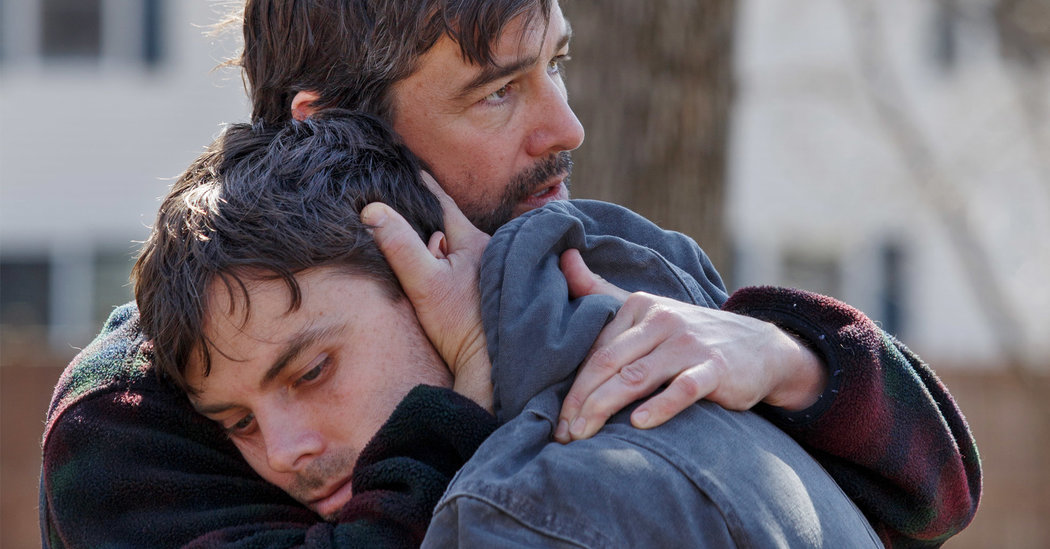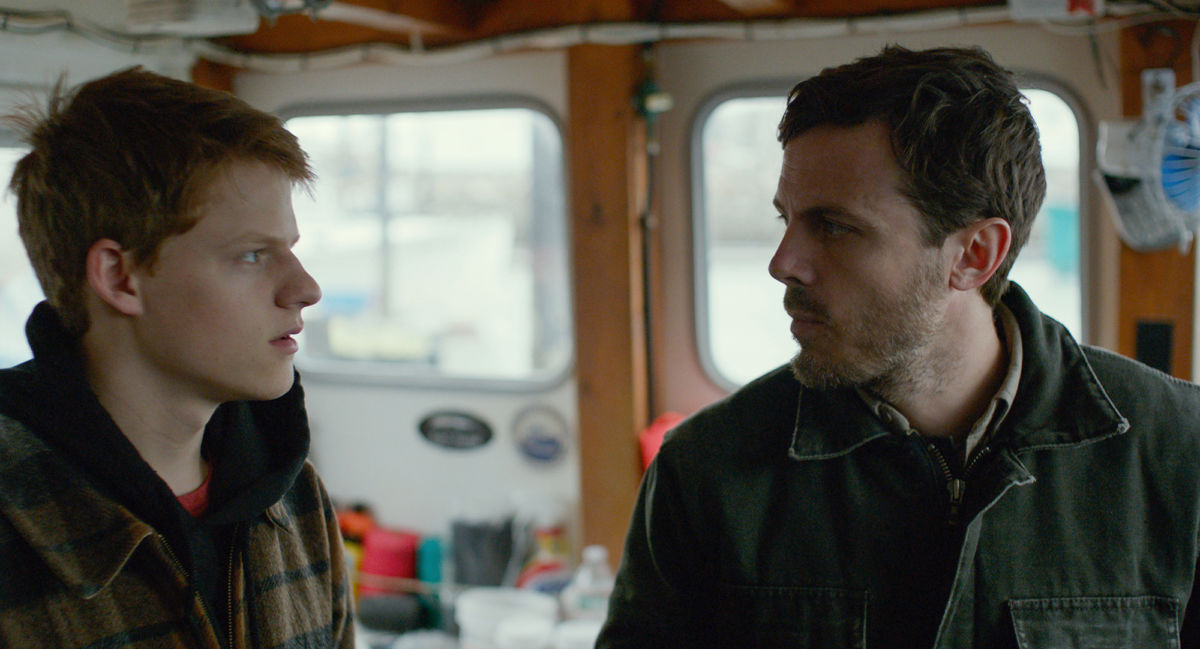
Nestled between the celebration of tradition and retrofitted nostalgia of “La La Land”, and the progressive iconography of “Moonlight”, “Manchester by the Sea” was the most classical of the standout films at the 2017 Oscars.
It’s a film that builds on older screenwriting structures, but does so with the ability of its director, Kenneth Lonergan, who has been deservedly praised for his narrative talent. With this particular film, he crafted a piece of cinematic art with a strength of vision and precision of execution that makes it a candidate for the best dramatic construction of the year.
1. The Respect for the Great Literary Tradition of the Last Two Centuries

A placid harbor, pale and innocuous houses with pitched roofs while the breeze gently caresses them, are a metonymy for the serene flow of life, for the entire American life with its lingering senses of uncertainty and the value given to everything that is ‘home’. To paraphrase Herman Melville, the human soul is like a serene island, while all around, violent storms and waves are raging.
“Manchester by the Sea” carries, within itself, the soul of the American province and the literary traditions of the land. The water is the soul of the city, and at the same time is the comforting breath of what everyone knows to be home, and the abyss that makes the characters feel small. The water is the source of life, and the potency of the sublime shining over everything.
Lonergan evokes the same literary spirit of “Big Wednesday”, albeit with a completely different tone, where the life of film seems to merge with the movements of the water, to reach an ontology of life on film. “Manchester by the Sea” is, in a way, a film about “being in the world,” with all the Heideggerian echoes that this definition carries with it.
The film has the acerbic nature of Raymond Carver, the transcendentalist search for meaning of Thoreau, the rural tragic sense of Faulkner, and the understatement of Hemingway.
If this could be classified as reaching, one has to keep in mind that the intelligence of Kenneth Lonergan is primarily literary and then cinematic, and the American tradition can only live in him, like it lives in Woody Allen, Stillman and other literary filmmakers. The film gets the pacing of novels right, the pace of a bird flying over the planes.
This list does not take into account what is perhaps the greatest literary influence, the Realist and “Verista” tradition, those novels that tried to depict the soul of an entire nation from the stories of humble people connected to their land.
The great Russian novelists, Gogol and Tolstoy; the great Italian writer Verga, whose greatest novel is centered on a community of fishermen and the way in which life crashes into them like waves, in which a boat is both the source of survival and the totemic object that represents the way in which life mistreats the living, in the way in which it is shaken by wild winds and sea storms.
Wind, snow, water, and the cold sky are the great non-human protagonists of the film; or maybe the city is a character itself, every street, every corner, every house, contains the scars of life lived.
2. The Best Protagonist of the Year, and His Wife

It might be an unpopular opinion, given the current criteria that are used to define great acting in Hollywood (although this year there has been a shift in the way the awards have been given), which usually consist of constant emoting, showiness, and physical transformations (such as Oscar winners DiCaprio, McConaughey and Bale, all extremely good actors).
However, Casey Affleck is leaps and bounds over the majority of his colleagues, for his ability to work with subtraction in a way that marries the mimetic school of acting with the communication of emotion through micro-gestures.
This is a quality that is owned by very few in this current decade (Ryan Gosling, Colin Firth in his best moments), which is, in short, the ability to be the character without ever being the character, something that goes over what is considered a naturalistic performance.
Because Affleck is able to give a naturalistic performance of the emotions of a character, something that is truly remarkable, he is the embodied objectification of grief, loneliness, depression, and in the few scenes where he is shown in his happier past, he portrays it without separating the two completely different personalities that he is portraying, but is able to find identity in difference.
Putting all this aside, his performance and his character are genuinely heartbreaking. It is a portrayal of loneliness so well realized that it inevitably achieves a universal status, and can be connected to a whole of variety of critical topics of contemporary and eternal discourses – fatherhood, masculinity, the working class man in times of economic crisis, love, death, and the persistence of memory.
Despite how great this character is, he would not be complete without the decisive complementary nature of his wife, who is not in the film for very long, but brings the full drama to its synthetic culmination in one of the toughest scenes of the year, both emotionally and thematically.
It is a sequence that is wonderfully acted, and acts as the connection between different timelines and different paths of life that have diverged and then flow into each other like the tide, for a passing moment (again a metonymy for the entirety of human relations in life).
3. Lack of Sentimentality

That scene is inevitably a showstopper, but Lonergan is very good at avoiding the inherent narrative construction of the melodrama, despite filming what can be easily classified as an example of melodrama.
The moment in which the husband and wife talk would be, in other cinematic hands, the apex of a crescendo engineered to achieve emotional catharsis from a careful act of establishing and building performed by the filmmakers, but Lonergan films the scene with a feeling of decrescendo, and a sense of melancholia of things that ARE and then pass so quickly that you don’t even have time to mourn.
The emotions of Affleck and Michelle Williams are achingly real, but the scenes doesn’t linger on them; the scene does not voyeuristically exploit the feeling in an attempt at pathos, but lets the viewer perceive a tiny bit of the abyss within the characters and then withholds it and hides from view again. The scene feels so brief that all the viewer can consciously perceive is the afterburn of that pain.
In the same way, the young Patrick is never dominated by his pain, but at the same time his grief is tangible, as a small pause, a glance, an apparently unmotivated panic attack, a certain lack of approachableness. The exploration of emotion through the length of the film, as what surrounds the apparently ordinary actions of the character, and not what the characters are all about, is the greatest writing achievement of the film.
It’s because we are not afraid of the world, we are not moved by the world – we are afraid of our feelings towards the world, we are moved by the intangible that we perceive in things but that is really going on within ourselves, so it makes no sense to display emotions (in a film) in a straightforward and cataclysmic openness, because the emotion is found by looking at what is not usually looked at.
All that is withdrawn is why Affleck punching the window feels like an explosion, because the world of the film is completely wrapped in morbid, unexpressed feelings. The film has the emotional roughness and the masochistic attitude to pain of a song by the Mountain Goats: “I hope I cut myself shaving tomorrow, I hope it bleeds all day long.”
4. Things Unsaid

This goes hand in hand with the treatment of emotional life of the previous point, but on a deeper level, because while the emotions are the relationship of what is said to what is unsaid, there is a vast area in “Manchester by the Sea” that never surfaces, like it’s hidden under the cold embrace of the Atlantic Ocean.
The first sequence in working-class Boston, that snowstorm that shakes the boats, a crappy apartment where a lonely woman desperately hopes for a man to magically appear and relieve her, all those places that Marc Augè would call the “non-places” that characterize postmodernity, supermarkets, hospitals, suburban houses where nothing is to be said and nothing can be said.
Watching a Celtics game on TV, watching a Bruins game on TV, just ‘being’ without being aware of ‘being’, without obsessing over it, but that idleness, that lethargic existence, leads us to the next point.
5. Obsession for the Mundane

If it is true that a seagull flying over the harbor has no inherent meaning or value, it is also of the universal symbols of melancholia, and the platonic idea of the soul floating away to the hyper-uranium, voicing our endless desperate need for transcendence. All metaphysical thought originates from careful observation of details, from the macroscopic to the minuscule.
Also, the way in which details connect to memory and how our brains explore correspondences and makes connections is the origin of nostalgia and emotion in the film. This way, burning the sauce in the kitchen becomes a terrible reminder of the failure of a father, frozen chicken becomes a reminder of a dead loved one – frozen, in a plastic bag – and the boat that you do not want to sell is an attempt at retaining memories of a person you have lost.
6. Hysteria and Tiredness (The American Way of Life)

The vision of Massachusetts in the film is that of a place that reveals all its Irish-ness and its American-ness together. It has a penchant for melancholia, for the feeling of always being far away in the past or far away in the future, the maddening fire of feeling, and the loneliness and alienation of American life.
The country has entered a phase of prolonged agony, and with understated agony comes a plethora of bottled-up resentment ready to be unleashed. Lee’s anger and boredom are not just personal but cosmic; they are representative of a demographic, of a collective sense of frustration.
Obviously the personal tragedy plays an enormous role in the psychological depiction of the character, but it’s more than just that. It’s living with his guilt in crappy bars and being approached by vacuous people; having worthless conversations and attempts at small talk by perfect strangers who are utterly uninteresting; doing a miserable job and being mistreated by the arrogance of customers; living in a hole in a largely depressed area; talking with a recovering alcoholic and her overly religious new boyfriend.
The explosions of hysteria that the film delivers are not just part of the development of the screenplay, but natural consequences of a life that is oppressive in its lack of significance, and exhausting in its endless protraction.
7. Black Humor

Life is a comedy for those who think and a tragedy for those who feel, or something like that. It is very complicated for us humans to find the balance between the macabre satire of life and keeping an empathetic attitude (which is not required, by the way). There is a moment in “Manchester by the Sea”, a joke about a body in a freezer, that is one of the funniest moments of the year in American cinema. It crucially comes in a film that is about loneliness, destroyed families, and funeral arrangements.
Irony is often used in conventional scriptwriting to alleviate the burden of the cinematic experience for the audience, as to simplify their experience. In “Manchester by the Sea”, irony is utilized in the same way in which it is in “Toni Erdmann”, another wonderfully written film, as a medium to slowly remove all the strata of constructed drama of the film and somehow reach the nakedness of the characters and of the story.
Author Bio: Gabriele is an Italian film student studying in Scotland. He is an experimental and arthouse cinema enthusiasta and a believer in the crucial importance of freedom of artistic expression.